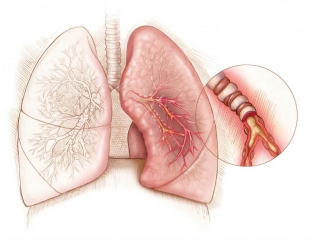Bronchial asthma is by far one of the most widespread and dangerous allergic diseases. Millions of people around the world can't take a single step out of the house without an inhaler, which they can need any second, anywhere. This severe allergic disease is chronic; throughout his life, the patient is forced to use medications in order to timely prevent or, if necessary, stop asthma attacks. A rather complex pathogenetic mechanism of this pathology suggests analyzing estet-portal.com.
Bronchial asthma pathogenesis: mechanisms of pathology development
Bronchial asthma currently affects about 20% of the population in developed countries. Many allergens that surround us daily stimulate increased sensitization of the body and are peculiar factors that predispose to the onset of bronchial asthma. The main danger of this disease is that with untimely medical care, the patient's lungs can completely stop working, resulting in death. Knowledge of the mechanisms of development of bronchial asthma is necessary in order to learn how to properly treat this severe pathology.
Pathogeny of bronchial asthma:
- what factors influence the occurrence of bronchial asthma;
- chronic allergic inflammation of the respiratory tract as a pathogenetic factor;
- what role does bronchial hyperreactivity play in the development of bronchial asthma.
What factors influence the onset of bronchial asthma
At the heart of the occurrence of bronchial asthma is chronic allergic inflammation of the human airways. Often the disease occurs in childhood and accompanies the patient throughout his life. Among children, boys are 30% more likely to get sick than girls, and their disease is more severe. There is a pattern between frequent allergic diseases in childhood and the occurrence of bronchial asthma. In addition, a genetic predisposition to this disease has been proven: if there were cases of this pathology among close relatives, the risk of developing bronchial asthma increases significantly.

Chronic allergic inflammation of the respiratory tract as a pathogenetic factor
Chronic allergic inflammation is the first important link in the pathogenetic mechanism of the development of bronchial asthma. When mast cells of the body release mediators of an allergic reaction into the blood, the tone of the bronchi and blood vessels that they affect changes. At the same time, histamine causes instant short-term bronchospasm, and leukotrienes – delayed and longer. Mediators also stimulate cellular infiltration: at first, eosinophils and neutrophils migrate, and with a longer process, monocytes and lymphocytes migrate. That is why therapeutic measures for bronchial asthma should be aimed at blocking the effects of mast cell mediators.
What role does bronchial hyperreactivity play in the development of bronchial asthma
The second important pathogenetic factor in the development of bronchial asthma is bronchial hyperreactivity, that is, their ability to respond with bronchoconstriction to various specific and nonspecific stimuli. Mediators such as histamine and methacholine directly affect bronchial obstruction, while factors such as exercise, cold air, bradykinin, and so on act indirectly. Normally, bronchial smooth muscle tone is regulated mainly by the parasympathetic fibers of the vagus nerve. It is the stimulation of these fibers that causes bronchospasm. This factor must be taken into account when choosing a therapeutic regimen for patients with bronchial asthma.







Add a comment